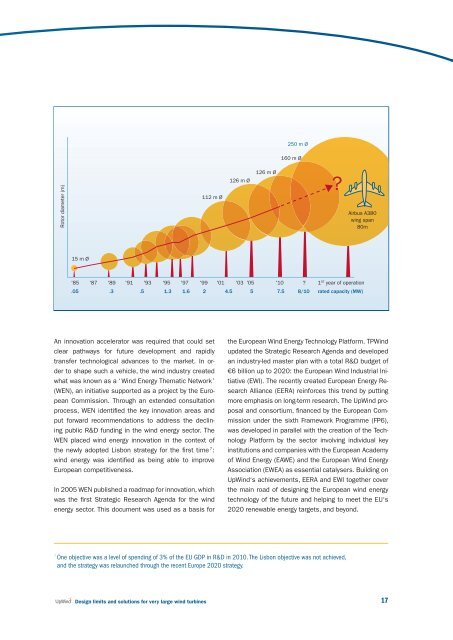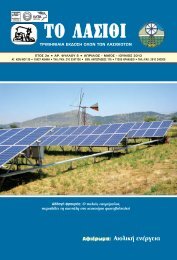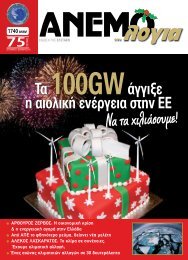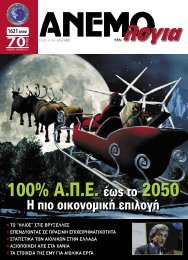Design limits and solutions for very large wind turbines
Design limits and solutions for very large wind turbines
Design limits and solutions for very large wind turbines
You also want an ePaper? Increase the reach of your titles
YUMPU automatically turns print PDFs into web optimized ePapers that Google loves.
2008<br />
250 m Ø<br />
160 m Ø<br />
Rotor diameter (m)<br />
112 m Ø<br />
126 m Ø<br />
126 m Ø<br />
?<br />
Airbus A380<br />
wing span<br />
80m<br />
15 m Ø<br />
'85 '87 '89 '91 '93 '95 '97 '99 '01 '03 '05 '10 ? 1 ST year of operation<br />
.05 .3 .5 1.3 1.6 2 4.5 5 7.5 8/10 rated capacity (MW)<br />
An innovation accelerator was required that could set<br />
clear pathways <strong>for</strong> future development <strong>and</strong> rapidly<br />
transfer technological advances to the market. In order<br />
to shape such a vehicle, the <strong>wind</strong> industry created<br />
what was known as a ‘ Wind Energy Thematic Network ’<br />
(WEN), an initiative supported as a project by the European<br />
Commission. Through an extended consultation<br />
process, WEN identified the key innovation areas <strong>and</strong><br />
put <strong>for</strong>ward recommendations to address the declining<br />
public R&D funding in the <strong>wind</strong> energy sector. The<br />
WEN placed <strong>wind</strong> energy innovation in the context of<br />
the newly adopted Lisbon strategy <strong>for</strong> the first time 7 :<br />
<strong>wind</strong> energy was identified as being able to improve<br />
European competitiveness.<br />
In 2005 WEN published a roadmap <strong>for</strong> innovation, which<br />
was the first Strategic Research Agenda <strong>for</strong> the <strong>wind</strong><br />
energy sector. This document was used as a basis <strong>for</strong><br />
the European Wind Energy Technology Plat<strong>for</strong>m. TPWind<br />
updated the Strategic Research Agenda <strong>and</strong> developed<br />
an industry-led master plan with a total R&D budget of<br />
€6 billion up to 2020: the European Wind Industrial Initiative<br />
(EWI). The recently created European Energy Research<br />
Alliance (EERA) rein<strong>for</strong>ces this trend by putting<br />
more emphasis on long-term research. The UpWind proposal<br />
<strong>and</strong> consortium, financed by the European Commission<br />
under the sixth Framework Programme (FP6),<br />
was developed in parallel with the creation of the Technology<br />
Plat<strong>for</strong>m by the sector involving individual key<br />
institutions <strong>and</strong> companies with the European Academy<br />
of Wind Energy (EAWE) <strong>and</strong> the European Wind Energy<br />
Association (EWEA) as essential catalysers. Building on<br />
UpWind‘s achievements, EERA <strong>and</strong> EWI together cover<br />
the main road of designing the European <strong>wind</strong> energy<br />
technology of the future <strong>and</strong> helping to meet the EU‘s<br />
2020 renewable energy targets, <strong>and</strong> beyond.<br />
7<br />
One objective was a level of spending of 3% of the EU GDP in R&D in 2010. The Lisbon objective was not achieved,<br />
<strong>and</strong> the strategy was relaunched through the recent Europe 2020 strategy.<br />
<strong>Design</strong> <strong>limits</strong> <strong>and</strong> <strong>solutions</strong> <strong>for</strong> <strong>very</strong> <strong>large</strong> <strong>wind</strong> <strong>turbines</strong><br />
17









